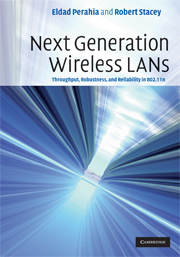12 - Transmit beamforming
from Part III - Transmit beamforming
Published online by Cambridge University Press: 04 December 2009
Summary
The capability to perform adaptive transmit beamforming is provided in the 802.11n standard. With transmit beamforming (TxBF), we apply weights to the transmitted signal to improve reception. The weights are adapted from knowledge of the propagation environment or channel state information (CSI). Since by definition transmit beamforming weights are derived from channel information, spatial expansion as defined in Section 6.2 is not considered transmit beamforming.
The key advantage with transmit beamforming is the ability to significantly improve link performance to a low cost, low complexity device. This advantage is illustrated in Figure 12.1, which depicts a beamforming device with four antennas. Such a device could be an AP or a home media gateway. The device at the other end of the link has only two antennas, typical of a small client device. Such a system would benefit from 4 × 2 transmit beamforming gain from device A to device B. However, when transmitting from device B to device A, the system gain would be matched with 2 × 4 SDM with MRC as described in Section 6.1. Therefore link performance would be balanced in both directions.
In Figure 12.2, the generic MIMO system is modified to illustrate the application of beamformer weights to the transmitted signal. To simplify notation, the system description is given in terms of the frequency domain for a single subcarrier. Transmit beamforming as described is applied to each subcarrier in the frequency band.
- Type
- Chapter
- Information
- Next Generation Wireless LANsThroughput, Robustness, and Reliability in 802.11n, pp. 307 - 367Publisher: Cambridge University PressPrint publication year: 2008
References
- 1
- Cited by



